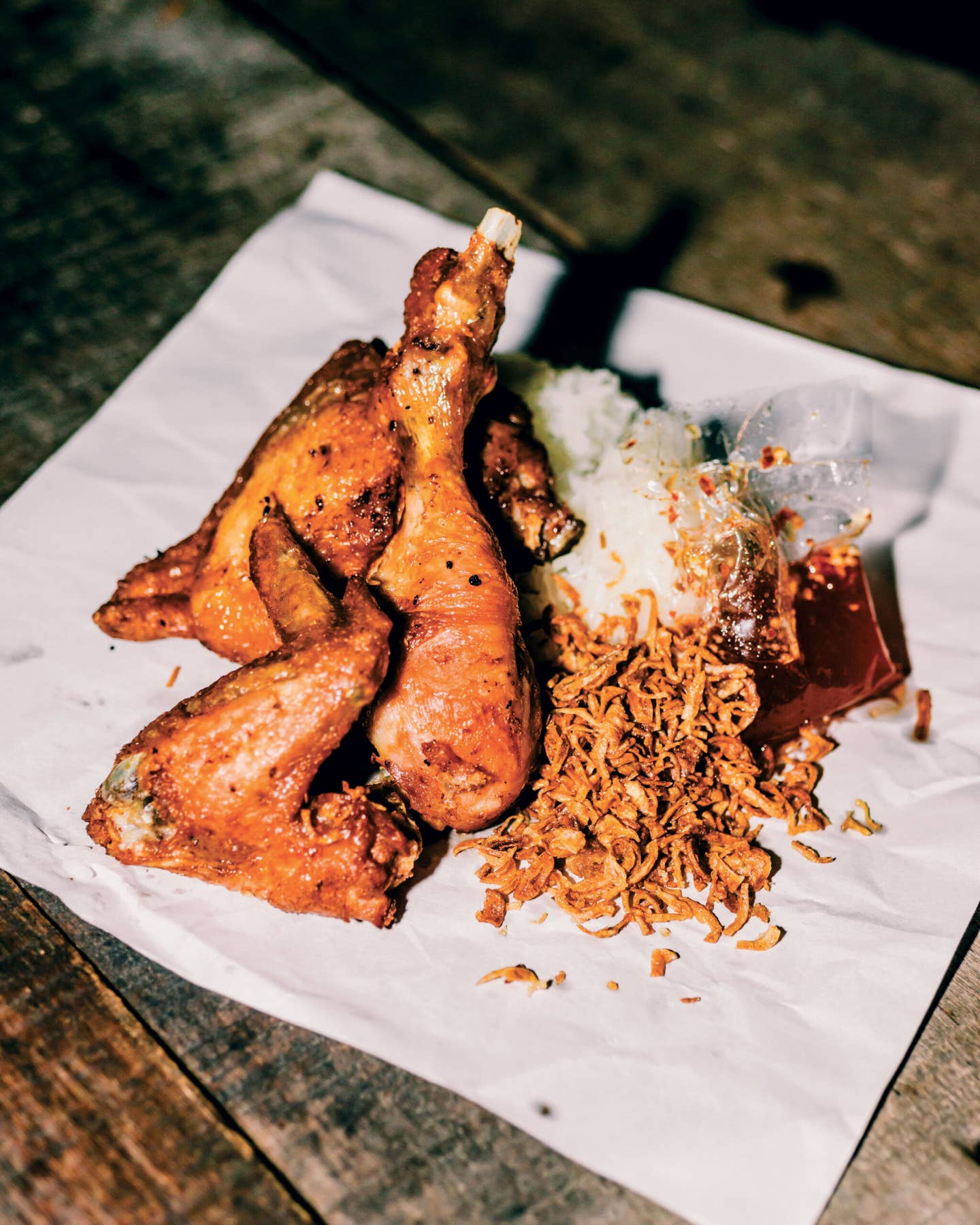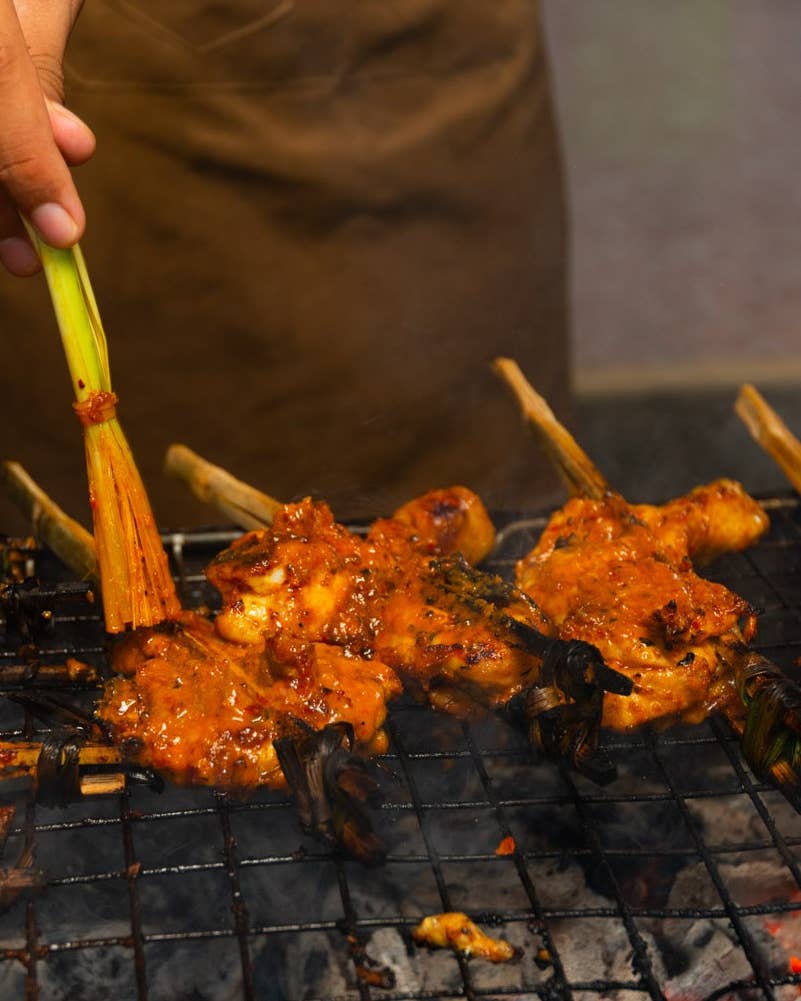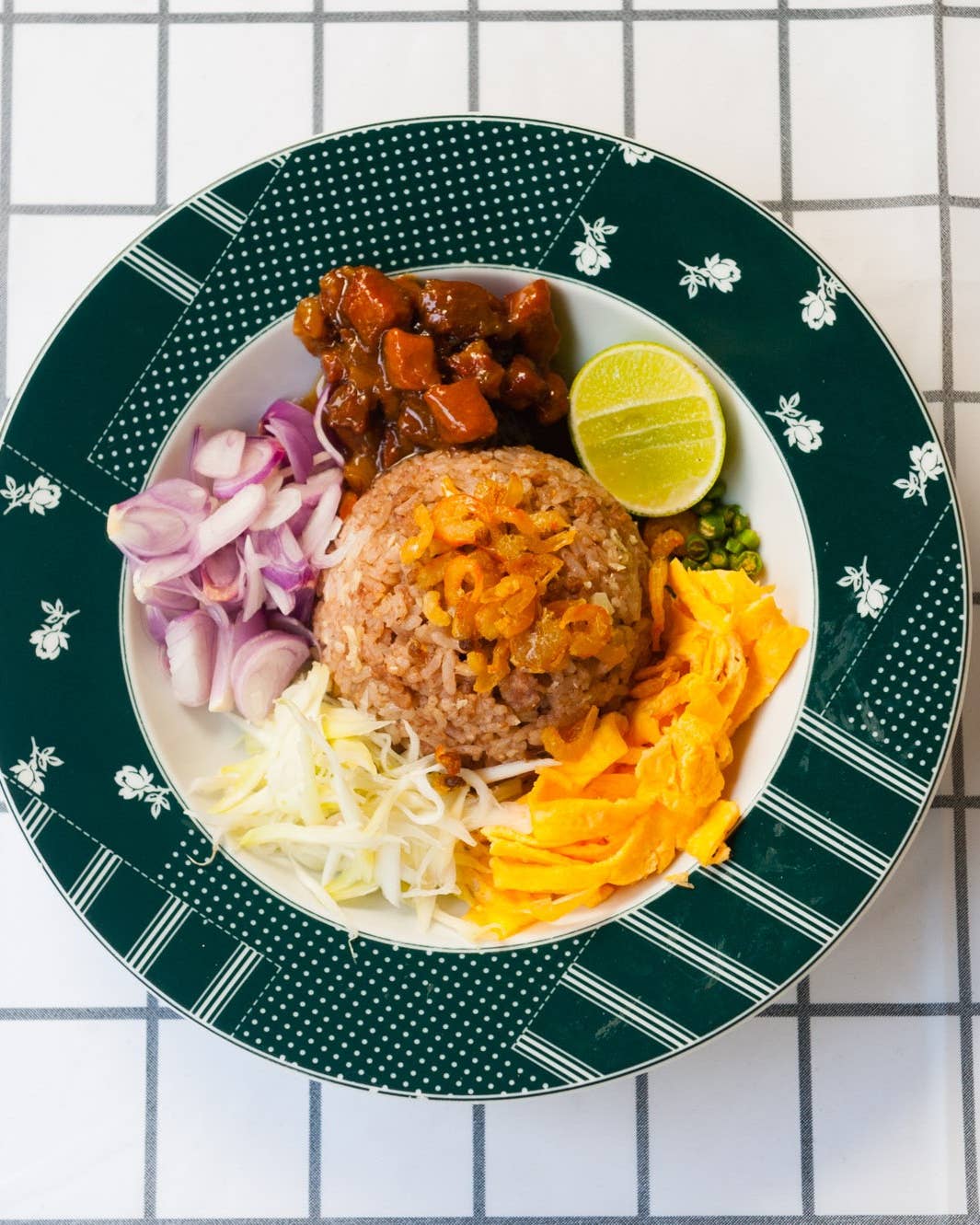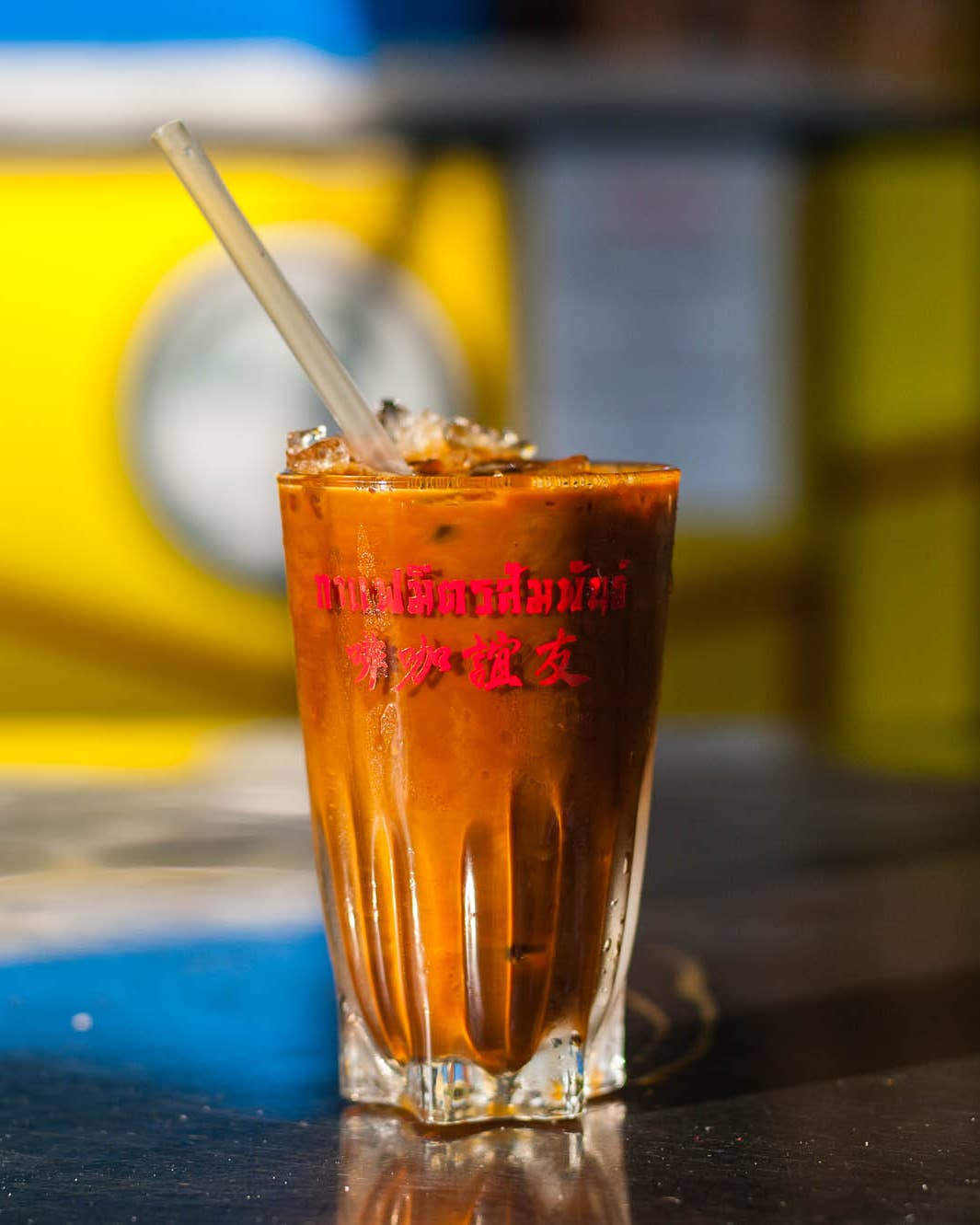Thai Fried Chicken
Straight from the street vendors of Hat Yai, kai thawt haat yai is served with crispy shallots, sticky rice, and a dynamite dipping sauce.
- Serves
4
- Time
1 hour 30 minutes

This recipe is brought to you by the SAVEUR Cookbook Club, our passionate community of food-loving readers from around the globe celebrating our favorite authors and recipes. Join us as we cook through a new book every month, and share your food pics and vids on social media with the hashtags #SAVEURCookbookClub and #EatTheWorld.
Near Thailand’s border with Malaysia, street vendors in the landlocked city of Hat Yai have perfected the art of fried chicken. This recipe for kai thawt haat yai infuses the chicken with flavor via a deeply savory brine of garlic, coriander seeds, sugar, soy sauce, and an optional—but highly recommended—dash of MSG. After frying in palm oil, what emerges is a sticky-sweet, bright orange, and irresistible taste of Southern Thai cuisine. Accompanied by a spicy-sweet dipping sauce and crispy fried shallots, and eaten in alternating handfuls with sticky rice, this is a dish that captures the vibrancy of the region.
Elements of this recipe can be easily adapted to fit taste and preparation preferences. The chicken can be a combination of bone-in cuts (though if using thighs and/or breasts, Bush suggests halving the pieces for easier frying). The MSG is easy to omit if needed, but Bush cautions that the dish will be missing some of its distinct flavor and bright orange color. Palm oil will allow for frying the chicken at a lower heat (and thus resulting in a crispier product), but you can also use vegetable oil. Glutinous sticky rice is traditionally made in a Thai-style pot and bamboo basket, but this recipe calls for steaming in a fine-mesh sieve with cheesecloth. Best of all, each element of the dish can (and should) be prepared in advance, making this an ideal make-ahead feast.
Adapted from The Food of Southern Thailand. Copyright © 2024 by Austin Bush. Used with permission of the publisher, W.W. Norton & Company. All rights reserved.
Featured in “Decades of Travel Inform This Guide to Southern Thai Cooking” by Jessica Carbone.
Ingredients
For the chicken:
- 1 heaping cup garlic cloves, peeled and smashed
- ⅓ cup sugar
- ¼ cup coriander seeds
- 2 Tbsp. plus 2 tsp. fine salt
- 2 Tbsp. plus 2 tsp. light soy sauce
- 1 Tbsp. plus 1 tsp. MSG, optional (see headnote)
- 2 tsp. freshly ground white pepper
- 4½ lb. bone-in, skin-on chicken pieces
- 4 cups palm oil, or vegetable oil
For the fried shallots:
- 6–8 shallots (8 oz.), thinly sliced lengthwise
- ½ tsp. fine salt
- 4 cups palm oil, or vegetable oil
For the dipping sauce:
- ½ cup fresh red Thai chiles
- ⅓ cup garlic cloves, peeled
- 1 tsp. fine salt
- 1 cup sugar
- ¼ cup plus 2 Tbsp. white vinegar
- 1 tsp. tapioca starch
For the rice:
- 2¼ cups Thai sticky rice (also called glutinous rice or sweet rice)
Instructions
Step 1
Step 2
Step 3
Step 4
Step 5
Step 6
Step 7
Step 8
Step 9
Step 10
- Brine the chicken: In a large bowl, stir together the garlic, sugar, coriander, salt, soy sauce, MSG (if using), white pepper, and 2 quarts of water until the salt and sugar are dissolved. Score each piece of chicken one or two times to the bone, then add to the brine, making sure the chicken is well submerged. Cover with plastic wrap and refrigerate for 5–24 hours.
- Fry the shallots: In a large bowl, toss together the shallots and salt. Transfer to a small wok, add the palm oil, and heat over medium-low until a deep-fry thermometer reads 250°F. Cook, stirring occasionally, until the shallots are golden, fragrant, and toasted, 25–30 minutes.
- In a fine-mesh sieve set over a bowl, drain the shallots, allowing the oil to drip through. Set the oil aside and transfer the shallots to a paper towel-lined plate. Once the shallots are cool and crisp, transfer to an airtight container and set aside.
- Make the dipping sauce: In a mortar and pestle or small food processor, grind the chiles, garlic, and salt into a coarse paste.
- To a small pot, add the sugar, vinegar, and ½ cup of water. Bring to a boil, then turn the heat to low and simmer, stirring occasionally, until the sugar has dissolved and the mixture has reduced slightly, about 5 minutes. Add the chile paste and simmer until the sauce has thickened slightly and reduced by about half, 8–10 minutes.
- In a small bowl, whisk together the tapioca starch and 1 tablespoon of water. Stir into the sauce and simmer until it has thickened to a syrupy texture, 2–3 minutes. Adjust the seasoning to taste, then transfer to an airtight container and set aside. (If making the sauce in advance, store it in the fridge.)
- Prepare the rice: To a fine-mesh sieve, add the rice and gently rinse under running water, stirring with your fingers, until the water runs clear. Transfer to a bowl, cover with about 2 inches of water, and soak for 4–24 hours.
- Cook the rice: Drain the rice, discarding the soaking water. Fill a large pot with 2–3 inches of water and bring to a boil. Line a fine-mesh sieve or bamboo steamer with cheesecloth, then add the rice to the sieve and set inside the pot. Cover with a lid that fully encloses the steamer, using a kitchen towel if necessary to create a tight seal, and cook until the rice is sticky and pliable, about 20 minutes. Using a spatula, carefully flip the entire mass of rice, then cover and continue cooking until the grains are tender and visibly stuck together, about 5 minutes more. Remove from the heat, transfer the rice to a large bowl or plate, and gently stir with a wooden spoon for about 10 seconds to release steam. Cover and keep warm.
- Fry the chicken: Set a wire rack over a large baking sheet. Remove the chicken from the brine, wiping away any garlic or coriander seeds, and pat dry with paper towels. Into a large skillet or wok fitted with a deep-fry thermometer, add the palm oil and the reserved shallot oil, then turn the heat to high. When the temperature reads 350°F, working in batches, gently add the chicken and fry, stirring occasionally, until fragrant and cooked through with crispy, orange skin, 8–12 minutes per batch, depending on the cut. (If using different cuts of chicken, cook pieces of the same cut together.) Adding the chicken will lower the temperature of your oil, so adjust the heat and oil quantity as needed to maintain a temperature between 335°F and 350°F. Using tongs or a spider skimmer, transfer the chicken to the prepared rack. Repeat with the remaining chicken.
- Transfer the fried chicken to a platter and serve hot or at room temperature with the fried shallots, dipping sauce, and sticky rice.
Keep Reading
Continue to Next Story










